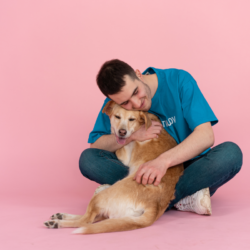Cognitive development in dogs is an increasingly important area of study. It offers enriching perspectives on understanding animal intelligence and on improving interactions between dogs and humans. This development encompasses a range of mental processes, from perception and learning to memory and problem solving. These processes are crucial to the well-being and adaptability of dogs in a variety of environments.
Recent research is shedding light on how dogs perceive their world, learn new tasks and compare their memory and intelligence with those of other animal species, including humans. For example, behavioural and neurobiological studies reveal that dogs have remarkable abilities to interpret human social cues and to solve complex problems.
Prenatal phase
The influence of the prenatal period on the puppy’s behaviour in adulthood remains little studied. However, it has been established that at the end of gestation, puppies develop tactile and gustatory sensitivity. They may be affected by maternal stress.
Research on rodents and primates has shown that foetuses at the end of gestation are sensitive to stress. This leads to behavioural problems such as reduced play, social and sexual disturbances, and increased emotionality. These effects are linked to the production of stress hormones such as adrenaline and cortisol in the stressed mother.
The researchers are mainly studying cats among carnivores. However, they also observed similar correlations in dogs. This indicates a relationship between maternal stress and the subsequent behaviour of the puppy.
Neonatal phase
The neonatal period extends from birth to the opening of the eyelids around day 14ᵉ. During this phase, the puppy is blind and deaf. It is entirely dependent on its mother, and moves around by crawling until 10-12ᵉ day. It is not autonomous for elimination and spends 90% of its time sleeping, the rest suckling.
Maternal presence and a good maternal instinct are crucial to avoid stress in adult puppies. The mother develops an attachment to the puppy during this period, and any separation causes deep distress.
Some bitches, particularly young, primiparous or poorly socialised bitches, may abandon their puppies. This situation, although rare, can occur in bitches that are hyper-attached to their owner, leading to disorders such as early detachment depression. This phenomenon can be observed in puppies born by caesarean section, orphaned or from mothers hyperattached to humans, resulting in depressed, inactive and non-communicative puppies.
Transition phase
The transition period extends from 2ᵉ weeks, when the puppies open their eyes, to 3ᵉ weeks, when they acquire hearing. During this phase, puppies become more mobile, sleep 60-70% of the time and begin to explore their environment.
This is a crucial time as it marks the beginning of the attachment bond between the puppy and its mother. Although the mother has displayed maternal behaviour since birth, the puppy’s attachment to her really begins between 2ᵉ and 3ᵉ weeks. In the absence of her puppies, the mother may panic, whereas before 2ᵉ week, a simple source of warmth was enough to soothe the puppies.
Thanks to this attachment, the mother becomes a reassuring base for the puppies, who explore their environment while returning to her regularly. This ensures their emotional stability. This period also marks the start of socialisation to the species, where the puppy learns to identify himself as a dog. Without attachment to the mother, this impregnation process does not take place.
Socialisation phase
The socialisation period extends from the puppy’s 3ᵉ week to 3ᵉ month. It is crucial for his behavioural development. From 4ᵉ week, the puppy can hear perfectly and becomes independent for elimination. Breastfeeding ceases between 5ᵉ and 6ᵉ weeks, and weaning begins.
During this period, puppies develop social and exploratory behaviours, marked by curiosity, play, and interaction with their environment. At five weeks, they learn bite inhibition and play and submissive postures appear.
Primary socialisation, which takes place during this sensitive period, enables the puppy to learn to recognise and communicate with members of its own species and with humans. The attraction phase (3ᵉ to 5ᵉ weeks) is followed by an aversion phase (5ᵉ to 7ᵉ weeks). In this phase, interest in novelties decreases.
During this period, the puppy also acquires sensory homeostasis, the balance between the body and its environment, which prepares it to face various stress-free situations in adulthood. The mother plays a crucial role, providing a reassuring base and helping the puppy to approach new things calmly.
Juvenile period
The juvenile period runs from 12ᵉ weeks to puberty (6 months for small breeds, 18-24 months for large breeds). It is characterised by two key moments: detachment and hierarchisation.
Detachment begins as early as 5ᵉ weeks, with the mother gradually pushing her puppies away. If the puppies remained with their mother after 2-3 months, detachment would continue until 4ᵉ-5ᵉ months for males and later for females. This stage encourages independence and integration into the social group. When a puppy is adopted at 2-3 months, it is in the middle of the detachment transition. The new family must continue this process by moving the sleeping area further away and avoiding departure and return rituals to prevent separation anxiety.
Prioritisation is also crucial. The puppy learns his place in the pack, understanding that he is dominated. Hierarchy is structured around access to food, territorial organisation, sexual hierarchy and contact management. The adoptive family represents the pack. It must maintain a clear hierarchy to prevent a puppy from developing dominant and sociopathic behaviour.
Notions of hierarchy
Groups of so-called social animals are coherent, permanent and organised, with stable relationships and synchronised activities. They are characterised by their demographic and spatial structure, and their organisation based on dyadic relationships between individuals.
Groups of feral dogs generally comprise 2 to 6 individuals. They often consist of pairs and their offspring, with a stable composition influenced by external factors such as human intervention. Unlike wolves, feral dogs show little cooperative behaviour in predation or maternal care situations.
Intraspecific social groups of dogs exhibit three types of behaviour: leadership, agonistic and affiliative. Leadership ensures group coordination and is often exercised by dominant, older individuals. Agonistic behaviours are linked to conflicts over access to resources and establish a dominance/subordination relationship. Affiliative behaviours, such as licking and playing, reinforce group cohesion.
The hierarchy within the group stabilises relationships and limits conflicts by organising access to resources. In dogs, this hierarchy is complex. It is also influenced by domestication and sterilisation, with stable dyadic relationships but no clear hierarchical organisation.





